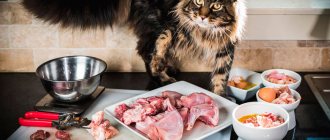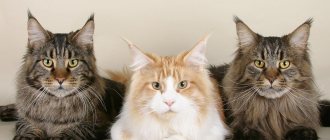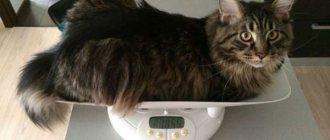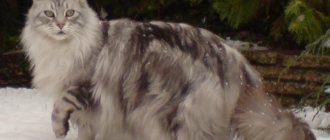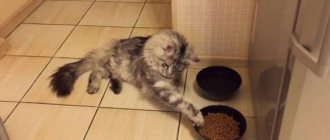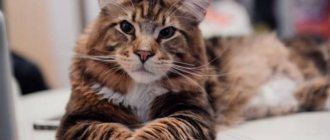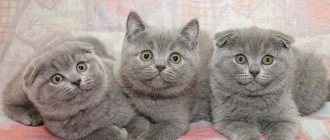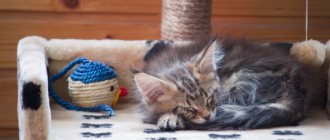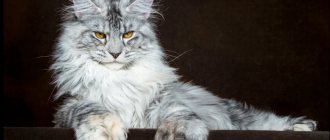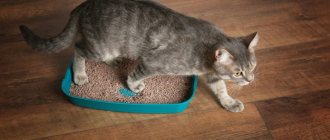Everyone knows how difficult it is to bathe cats, especially large cats like Maine Coons. However, their long, showy coat requires careful and regular grooming. We'll tell you how to properly wash a Maine Coon, how often it should be done and what products to use to make your pet look chic and well-groomed.
How often to bathe Maine Coons
Dust, accumulating static electricity, dry air in city apartments - all this does not have the best effect on the coat. Therefore, regular care and washing are necessary for cats, even if they do not belong to the show class . Typically, bathing is indicated for pets in cases of heavy soiling, contact with toxic substances on the fur, or infection with ectoparasites.
In addition to these cases, it is recommended to wash Maine Coons once every three to four months. This procedure is not only hygienic, but also cosmetic in nature, it gives the wool a special shine and prevents it from matting.
Another circumstance affects the frequency of washing Maine Coons. In mature, uncastrated cats (as an exception - in cats), the sebaceous glands located at the base of the tail secrete a fat-like substance. When it settles on the fur, it glues the hairs in this area; sticky layers form on the adjacent areas of the back. A luxurious tail that turns into an “icicle” is a signal that it’s time to bathe the animal.
Important! A “greasy tail” not only looks unsightly, but can also lead to serious medical problems if the fur and skin are not promptly cleaned of fatty secretions.
Return to content
At what age should I introduce water?
If your pet still has negative emotions, then next time he will fight back hard: scratching, biting and struggling with all his might. That's why you need to turn bathing not only useful, but also a pleasant pastime.
Some breeders claim that a kitten can be washed from the age of one month. This is explained by the fact that such a baby practically does not resist and does not scratch. But it’s not worth risking the baby’s psyche, because any unknown procedure is a great stress for him.
Preparation for water procedures
At the preliminary stage, you need to prepare everything you need to wash your Maine Coon. You will need:
- an anti-slip mat or towel to place on the bottom of the bathtub;
- harness with a carabiner on a suction cup to secure the animal during the procedure;
- rubber pad for combing wool;
- small soft brush;
- brush with medium-hard bristles;
- 2 large terry towels;
- all the necessary set of zoocosmetics for washing.
Separately, it should be said about skin and coat care products that are used to wash Maine Coons.
- Shampoo and conditioner for long-haired cats is sufficient as part of normal hygiene procedures.
- To prepare for an exhibition or bathe an animal with a noticeably greasy tail, groomers and veterinarians recommend additionally using degreasing paste and coloring, texturing, and conditioning compounds.
- For white Maine Coons, you can choose special products to eliminate the yellow tint and lighten the coat.
- For baby cubs, hypoallergenic shampoos of the “tearless” category are intended, the composition of which, in addition, takes into account the characteristics of the soft texture of the kitten’s fur.
Important! The pH balance of human and animal skin is different. Therefore, you should not wash your cat with shampoos intended for humans. The result of using such detergents for Maine Coon will be dry, irritated skin, dandruff, poorly cleaned and dull coat.
Before washing, comb or cut out matted hair and tangles in problem areas of the pet - the lower neck, armpits, behind the ears, on the stomach and panties. Also, if necessary, trim the claws . Only after all breakable and potentially dangerous objects have been removed from the pet’s reach in the bathroom, do they begin bathing.
Return to content
When not to wash your pet
Bathing for an animal is always a strong stress to which its immune system is quite sensitive. Stress is also caused by moving to another house, staying at an exhibition, changing the usual environment, food, the appearance of noisy guests or other pets. Therefore, bathing a cat in such situations is not recommended. There are also a number of special contraindications for washing an animal:
- during any illness;
- being in quarantine;
- before vaccination.
There is no need to immediately bathe the kitten after you bring it to your home. Such bathing can only be harmful to the baby’s health.
Whether a Maine Coon needs to be washed periodically or not, and how often to do it, is up to each owner to decide for himself. But you must admit, it’s nice when a clean and good-smelling cat walks around the house, and not a ball of fur hung with icicles with a shiny tail. When choosing a cleaning product, use only special shampoos, creams and sprays for grooming, taking into account the age, gender and color of the animal. It is also necessary to select funds experimentally. If, despite regular water treatments, the coat quickly loses its grooming and shine, perhaps the Maine Coon should be shown to a veterinarian. And remember: bathing for a mustachioed pet is not the most pleasant procedure, but is always stressful. Therefore, do not try to overdo it in the pursuit of cleanliness and beauty; think first of all about your pet’s health and well-being.
Bathing a Maine Coon kitten
How the baby’s first acquaintance with the bath procedure goes will largely determine the animal’s further attitude towards washing. Therefore, all actions should be aimed at making the process the least intimidating.
- You need to bathe a kitten no earlier than two weeks after it arrives in the house: the stress of moving and washing will reinforce each other.
- You don't need a water container that is too large - the bath is perfect for an adult Maine Coon, but it will be uncomfortable for a small one. The best option is a plastic basin with high sides, in which the kitten can stand, firmly resting on its paws. It would be a good idea to place a towel or mat on the bottom of the basin to prevent slipping. The height of the water should be such that it reaches the pet’s neck, completely covering the body. The temperature of the water is also important: the range from 36 to 39 °C is considered comfortable.
- The kitten is placed in a container and a pre-prepared retainer is secured around the neck or held firmly by hand. The fur is gradually moistened (do not use a shower) and then foamed shampoo is successively applied and rubbed into it. You can only wet your head with a sponge to prevent water from flowing into your ears. Since Maine Coon kittens do not yet have the problem of greasy tails, they limit themselves to one-time soaping.
- After washing, the kitten will definitely begin to lick itself. To prevent detergent residue from entering the stomach and causing poisoning, the shampoo must be rinsed off very thoroughly, changing the water in the basin 2-3 times. The procedure is completed by lightly squeezing the wool with a towel, as well as obligatory praise of the baby for courage and bravery.
Important! When washing, you should never be impatient or nervous. Even at a very tender age, Maine Coons perfectly feel and perceive the mood of their owner. Sudden movements and intonations will further increase the kitten’s fear of an unfamiliar environment. Soothing, approving words, confident but gentle movements are the only correct human behavior when bathing a small pet.
For minor stains, an alternative to bathing can be using dry shampoo, but this does not replace a full wash and does not give the kitten any idea about it.
Return to content
First swim
The first time is the most important. If you manage to do everything correctly, do not scare the baby, and he feels pleasure from water procedures, you will save yourself from big problems in the future.
The most common mistake is giving a kitten a bath for the first time. Large, with a lot of water, it will certainly frighten the kitten. In addition, it will be very inconvenient for you to wash it at an angle, leaning over the side and putting your hands down. Be sure that as soon as you hesitate for a second, the kitten will “fly up” onto your neck or head, climbing up your arms like up a tree trunk.
The most convenient way to wash your baby is in a basin or sink. You need to put a rubber mat or a small terry towel on the bottom. The water temperature should not be higher than 38 - 40 degrees, the “depth” should not be more than three centimeters.
It will be right if you prepare everything you need in advance: a large fluffy towel, shampoo, a bowl of water. If you have to wash the kitten alone (although it would be more convenient for two), unscrew the cap on the shampoo in advance. Prepare a couple of cotton balls soaked in sunflower oil to plug your baby's ears with, otherwise water may get into them. By the way, protect your eyes by smearing their corners with Vaseline oil.
Bathing an adult cat
Washing an adult Maine Coon takes longer and is more labor-intensive.
- First of all, the animal is seated in the bathtub and secured with a harness.
- The preliminary step should always be basic degreasing: a special paste is applied to the dry fur of the most greasy areas - tail, back, collar and behind the ears - with a brush and left for 5 to 8 minutes (the exact time is specified in the instructions for the product).
Important ! For deep cleansing in the most problematic area, the upper part of the tail, the hair should be worked through to the skin.
- Then wash off the paste with warm water, not forgetting to fold the animal’s ears so that water does not get into them.
- A small amount of degreasing shampoo is first rubbed in the palms of the hands and applied with massage movements to the coat along the hair growth, paying special attention to the tail. The paws are washed with a brush, the body with a pad. This allows you to remove dead hair at the same time as washing. If the animal is washed regularly, it is enough to apply degreasing shampoo once, after which it is washed off with running water.
- To restore the structure of the coat and saturate each hair with keratin, use a texturizing shampoo, rubbing it in as thoroughly as a degreasing shampoo, and then rinse it off until the flowing water becomes clear.
- Coloring is done only when necessary - it is more of a decorative measure than a hygienic one. Experiments with color are usually carried out on the eve of exhibitions and for Maine Coons of a certain color.
- The wash is completed with conditioning, the purpose of which is to return natural fatty lubrication to the hair, close the hair cuticle, and protect it from external adverse influences. Conditioner with an added drop of liquid silk is applied to areas with top coat hair: this gives the coat an amazing shine. The remaining areas can be treated with the product without additive.
Carry out the final rinse thoroughly, and if the wool creaks under your hand, it means it has been washed well.
Return to content
Documentation
Before purchasing a Maine Coon, the breeder is required to provide the buyer with the following documents:
- Veterinary passport of the animal with all vaccinations;
- A purchase and sale agreement, which specifies the terms of purchase and is drawn up according to the rules of felinological systems;
- Pedigree;
- A certificate or document indicating the rules for caring for the kitten;
- Pedigrees and confirmation of parents' titles;
- Registration in felinological systems (desirable).
If the breeder refuses to provide the documents described above, then you should not purchase an animal from him.
A professional breeder will tell you all the necessary information before purchasing, but find out a few nuances:
- Find out what food the kitten ate;
- What filler does the specialist use? This will help the kitten get used to the new place and determine where exactly to go to the toilet;
- Get information regarding your Maine Coon's health, character and habits.
Maine Coons are smart, loyal and incredibly beautiful cats that will become not just a pet, but a full-fledged member of the family.
Drying wool after bathing
The process of drying Maine Coon wool also has its own characteristics: it is probably impossible to do this without an assistant.
- The cat's entire body is wrapped in the first towel and the fur is blotted with light squeezing movements.
- Then they take another towel and cover the animal with it on top.
- One front corner is pulled under the belly, the second one covers the front legs. Both corners are connected, tied behind the cat’s back and waited for about 10 minutes so that excess moisture is completely absorbed into the fabric.
- Remove the towel and comb the wool everywhere, at the same time unraveling and removing tangles if they formed during washing.
Then they use a hairdryer if the cat is accustomed to it.
- The main drying begins with the panties: the wool is pressed against the body and the air flow directed against the wool gradually works through individual strands.
- When drying the body, it is better to lay the animal on its side on a horizontal surface. The helper grabs both pairs of paws above the hocks and holds the cat. The groomer, running a fine comb against the fur, uses a hairdryer in turn to work all areas of the body, the outer and inner surfaces of the paws.
- The tail is dried using a hairdryer and a slicker, moving in a spiral against the hair from the base to the end.
- Lastly, the collar and tummy are treated.
If the wool is well dried, the comb passes through it easily . A cat, not accustomed to a hairdryer since childhood, has to be dried in the same way, constantly holding the animal, breaking and combing the damp strands of fur.
A loving owner who spares no time and effort in washing the Maine Coon will be rewarded with a shiny, smooth, well-groomed, silky coat of the pet.
Return to content
Contraindications
If the kitten has been vaccinated, it cannot be bathed for two weeks. If castration is performed - 10 days. If you are treating your pet for lichen, do not be surprised that with this disease, bathing is not only not prohibited, but is even useful.
However, this will not be an ordinary bath, but rather a therapeutic one; during it, the products that your veterinarian will recommend should be used.
Interesting topics
What else to read:
- How to choose a tray and litter for a kitten It’s not enough to just get a kitten and give it your love, you need it.
- How to cure an umbilical hernia in puppies and kittens Contents of the article Reasons Which breeds are more susceptible Main symptoms Diagnosis in a veterinary clinic Treatment method and prognosis What.
- 12 tips on how to stop a kitten from scratching and biting Contents of the article Why kittens can bite and scratch Recommended age for weaning.
- The kitten does not eat: reasons and necessary measures Contents of the article Reasons for refusing food Necessary measures at home Diagnosis in a veterinary clinic Recommendations for.
© Veterinary clinic "Belanta", 2004—2021, Moscow
Bathing frequency
There is an opinion that cats do not need to be periodically bathed and their fur cleaned of accumulated dirt. Due to the uncertainty on this matter, the question of whether Maine Coons can be washed is being asked more and more often.
Some believe that water disrupts the natural state of the fat layer.
And others think that water procedures should be carried out only in case of severe contamination after a walk on the street or due to renovations in the apartment. Or for another reason.
However, this procedure should not be canceled. Although many people still don’t know how often they can wash a Maine Coon.
Many groomers and experienced breeders know that Maine Coons need to be bathed at least once every two months. During this period of time, fat is released, which subsequently covers the animal’s fur.
And then a large amount of dust and dirt accumulates on it. And because of this, the air exchange process is disrupted and hair growth slows down.
By ignoring bathing for a long time, the pet owner risks worsening the condition of the cat’s fur, which can break into strands and turn into terrible tangles.
It is easier to cut off the resulting tangles than to try to comb them out. For this reason, there is no need to delay with water procedures. And just before bathing, you should understand in detail how to wash a Maine Coon cat correctly.
Maine Coons often become the main stars at cat shows. And regular and more frequent washing before showing will ensure a neat appearance of the animal and a high chance of winning. Shedding time should also be accompanied by a bath.
Some people believe that water disrupts the natural state of the fat layer when washing a Maine Coon. This is not true./Yandex Collections
Bathing is not the only procedure that needs to be carried out regularly. The Maine Coon's coat is long and showy. And often there is a lot of it. Especially scraps that fall out around the apartment if you don’t comb them out in time.
Once every two weeks will be enough. In the process, various combs are usually used, for example, with a fine comb or teeth. A downy comb is also suitable for the undercoat. Every owner of such a pet should know how to properly wash a Maine Coon.
Personal impression
It is impossible to choose the right kitten based only on classic characteristics. Especially if you choose a pet for yourself and are not going to breed.
When choosing, also consider your personal feelings. If you feel that this is your animal, and when you see it, something inside responds, this is a sure sign of the right choice. If, on the contrary, everything is in order according to the documents and appearance, but you don’t experience any emotions at all, think again, don’t rush.

